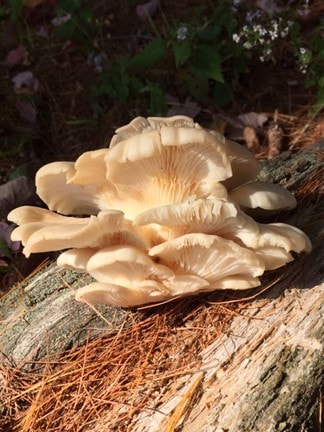 This year I have spent a lot of time in the woods to escape the parched earth and the relentless heat during the hottest summer I ever remember. In the woods it was still cool and moist, and although mushrooming was poor overall, I still found some of these fungal fruiting bodies growing in the usual places. Recently I was delighted to discover an oyster mushroom cluster growing on a dead poplar tree. I love these pearl white oysters because of their graceful clustering shapes, and of course, they are edible – especially tasty when young. They first begin appearing in June and can be found throughout the summer and sometimes, like this year, during the fall. How does drought affect the timing of emerging mushrooms, I wonder. Does the underlying mycelium take advantage of rains that come at unusual times and begin fruiting when conditions are right? We have two common species of oyster mushrooms that grow in our area –Pleurotus populinus grows only on poplar and aspen trees. It has a white spore print and an ivory colored fruiting body and P. ostreatus grows on hardwoods like sugar maples and beech. It has wheat or grayish caps, and a lavender spore print. This latter species is more common in the fall. The gills are fairly close together and run down the stem which is usually non – existent. However, the two species overlap; I’ve seen both growing around the same time. Both species have an anise –like aroma. Other Oysters appear periodically.
For anyone new at mushrooming, taking a spore print is a reliable way to identify a mushroom and very simple to do. All one needs is a piece of black and white paper. When the mushroom has opened pluck two caps and place each under a jar, one on each of the two papers. I wait a full 24 hours before checking any print. For P populinus the spore print is white, so if you want to see it more clearly a piece of black paper works more effectively, I think. With this much said, this particular mushroom is so distinctive from a visual standpoint that I have never actually seen a print of it because I have never taken one! The artist in me loves mushroom spore prints; I have sometimes sprayed some to keep for a while because I find the patterns astonishingly beautiful. Oyster mushrooms can be found in many supermarkets across the country because they are so popular. Not only are they tasty but they have medicinal value as well. There is mounting evidence that oysters are useful in the treatment of various cancers. When I find a cluster I sauté them in olive oil with garlic as soon as possible. Otherwise they become quite chewy. There is one oyster mushroom that should be avoided: ‘Angel Wings’. This one grows on conifers and the clusters are thin and white. They don’t look like other oyster mushrooms to me. There are other oysters around with dubious qualities. I always err on the safe side when collecting any mushroom I eat. For that reason I stick to P populinus and P. ostreatus because I know I can identify them. Paul Stamets, a prominent mycologist has demonstrated that strains of oyster mushrooms can break down the structure of hydrocarbon molecules effectively cleaning up pollutants like diesel fuel, oil, gasoline, and PCB’s – No small feat. If only our present culture would fund the necessary research we could begin using this natural and organic means of dealing with our human induced waste. Oyster mushrooms are sometimes used for dying wool. Pleurotus fungi are found in both tropical and temperate climates throughout the world. Most species act as white rot fungi on hardwoods (and some conifers) meaning that the fungus eventually breaks down decaying wood turning it into soil. One fascinating fact is that all species catch nematodes by paralyzing them with a toxin. Because I spend so much time in New Mexico I had to research whether or not oyster mushrooms could be found there and I wasn’t disappointed. At the higher elevations (above 7000 feet) these mushrooms can be found in wooded places during monsoon season. I am guessing that some might be found on the Pedernal. Unfortunately New Mexico is suffering from severe drought and wildfires that destroy the trees on which these fungi grow, but apparently oyster mushrooms have been found recently in the mountains around Taos and Sante Fe. A guardedly hopeful note.
0 Comments
Your comment will be posted after it is approved.
Leave a Reply. |
Submit your ideas for local feature articles
Profiles Gardening Recipes Observations Birding Essays Hiking AuthorsYou! Archives
October 2025
Categories
All
|
 RSS Feed
RSS Feed